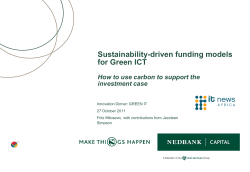
Challenges and way forward in implementing eco-efficiency at the city level -
Challenges and way forward in implementing eco-efficiency at the city level - How to quantify citywide greenhouse gas emissions based on the consumption approach? October 17-18, 2011 Suwon, Republic of Korea Wee Kean Fong, PhD Senior Associate, GHG Protocol China GHG Protocol www.ghgprotocol.org Eco-efficiency and GHG accounting How to quantify? - Citywide GHG emissions e.g. BOD, CO2, energy, water… Environmental Cost Eco-efficiency = Economic Output e.g. GDP, km, m2… Why accounting GHG emissions? You Can’t Manage What You Can’t Measure Establishing baseline emissions Determining current emissions (update) Setting reduction targets Identifying sources of emissions Developing reduction strategies GHG accounting and low-carbon city planning Scenario Development Existing Condition Analysis GHG Accounting Protocol & Tool Baseline Target Setting & Allocation Low-carbon city planning and implementation process Technology Roadmap Action Plan Performance tracking Implementation Existing guidelines/standards Standard/Protocol Int’l Standard for Determining GHG Emissions for Cities, UNEP et al. Tools 2010 Int’l Local Gov’t GHG Emissions Analysis Protocol, ICLEI Project 2 Degrees - C40 The CO2 Calculator - Denmark 2005 Bilan Carbone - France ECO2Region - Switzerland, Germany, Italy CO2 Grobbilanz & EMSIG - Austria 2000 GRIP - UK Issues & challenges Focus only on direct emissions Mixing up direct and indirect emissions Indirect emissions/impacts in other cities? Emission leakages? Global reductions? Recognizing the effort changing lifestyle and consumption pattern to reduce emissions? Solution + Production-based emissions Consumption-based emissions Source of graphics: http://www.triplepundit.com/2010/03/enviance-carbon-reporting/ http://www.fairloanrate.com/2009/04/04/economic-myths-in-america-part-ii-consumption-myths/ Production-based GHG accounting 1,000,000 500,000 tCO2e A City 1,000,000 1,500,000 tCO2e B City Consumption-based GHG accounting 500,000 tCO2e 1,500,000 tCO2e 500,000 tCO2e 500,000 tCO2e A City Direct emissions = 500,000 tCO2e Indirect emissions = 1,000,000 tCO2e 500,000 tCO2e B City Direct emissions = 1,500,000 tCO2e Indirect emissions = 500,000 tCO2e Emission Leakages carbon Importing Cities goods Incentives Producing Cities Incentives •Carbon reduction •Low cost goods • Trade surplus Risks • Increased emissions Emission reduction = Difficult to achieve national reduction Emission increase Example 1: Oregon State, USA Emissions embodied in imported electricity Emissions embodied in imported goods/services Source: David Allaway and Peter Erickson, 2010 Example 2: Denver, CO, USA Indirect emissions: • Cross boundary transportation • Air travels • Embodied emissions in materials (concrete & food) • Wastes Per capita emissions mmtCO2e Direct energy use 19.1 Direct energy use 25.3 + air travels + embodied emissions Greenhouse Gas Inventory for the City & County of Denver, 2007 Direct and indirect emissions Indirect Emissions Scope 3 Emissions All other indirect emissions that are a consequence of the activities within the city, but occur from sources outside the geopolitical boundary of the city. Direct Emissions Scope 1 Emissions All direct emissions occur from sources within the geopolitical boundary of the city. Indirect Emissions Scope 2 Emissions Indirect emissions from the generation of imported electricity, district heating, steam and cooling consumed by the city. Example of direct and indirect emission sources SCOPE 1 EMISSIONS (Conventional Inventory) SCOPE 3 EMISSIONS (TRANSPORTATION) SCOPE 2 EMISSIONS Industries (primary, secondary, tertiary) SCOPE 3 EMISSIONS (DOWNSTREAM) Residential Electricity Transportation SCOPE 3 EMISSIONS (UPSTREAM) Solid waste treatment Land use change Wastewater treatment Goods production Wastewater treatment Solid waste treatment Fuels not in Scopes 1 or 2 UPSTREAM ACTIVITIES Use of final goods REPORTING CITY Process of goods End-of-life treatment of final goods DOWNSTREAM ACTIVITIES Benefits of consumption-based approach Global GHG reduction Allow local government, businesses, and residents to assess both direct and indirect GHG emissions of their activities Avoid emission leakages Help government to draw policies and strategies to cut emission within and outside the city It recognizes not only the control of direct emission sources within the city, but also reduction of indirect emissions due to change of lifestyle and consumption pattern Source of photo: http://www.ghgprotocol.org/feature/invitation-inform-new-initiative-ghg-policy-accounting GHG Protocol for Cities Piloting the new GHG Protocol Video
© Copyright 2025





















